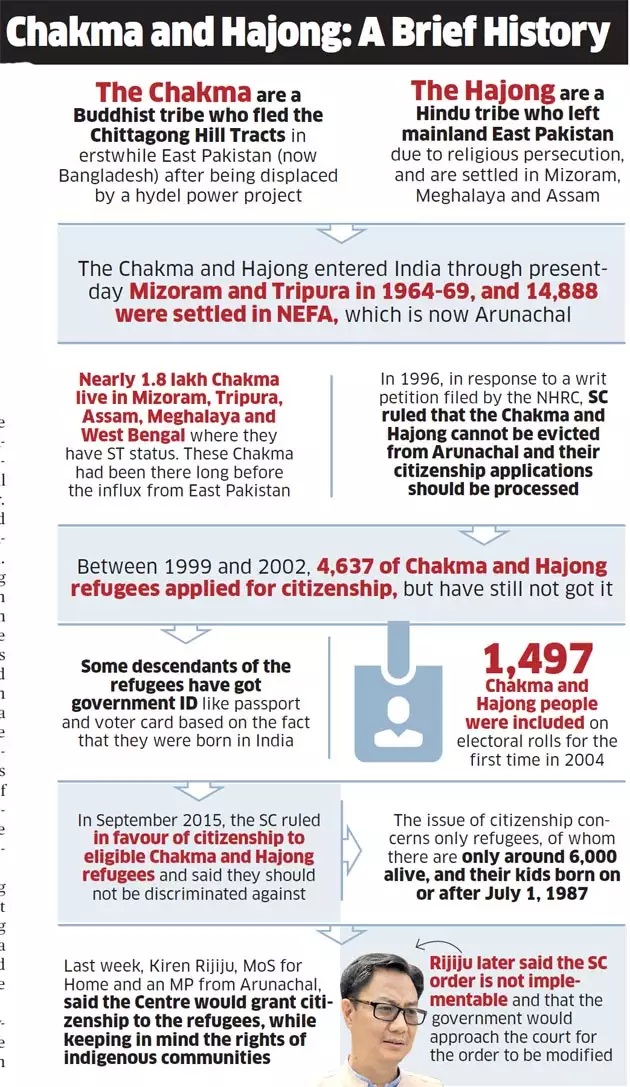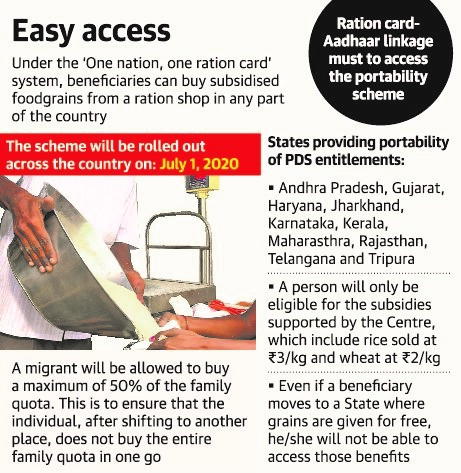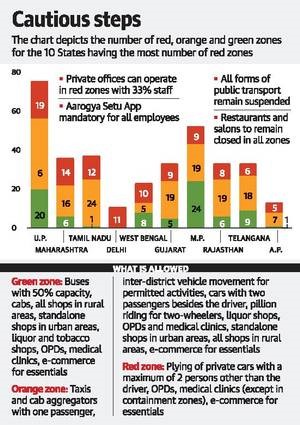2nd May 2020 Current Affairs in English

2nd May 2020 Current Affairs in English – Today Current affairs PDF link available below.
Dear Aspirants, we (Vetripadi.com team) have come with Daily Current affairs analysis. It is prepared to crack the various competitive exams. We are here to make sure your preparation easy. We will update the current affairs every day. It will help for both preliminary and mains (facts oriented with background information) for your preparation. We need you support.
VETRIPADI Daily Newsletter
வெற்றிப்படி.காம் | வெற்றிக்கு நீ படி!!!
Daily Current affairs for Competitive
Exams ( UPSC, TNPSC, SSC)
2nd MAY2020
TABLE OF CONTENTS
-
- Railways run ‘Shramik Specials’ to ferry stranded
- NRAI launches scheme to help restaurants
- Add Chakmas and Hajongs to relief plan
- Coronavirus | U.P., Bihar migrants can now avail ration portability
- Direct taxes revenues defy lockdown, jump 36.6% in April
- Adopt a cobra for ₹2,000, an elephant for ₹1.75 lakh
- Environment Ministry gives nod for new Parliament project
- Health Ministry identifies 130 districts as red zones
- GI tag to Kashmir saffron, Kovilpatti kadalai mittai, Manipur black rice, Gorakhpur terracotta
1. Railways run ‘Shramik Specials’ to ferry stranded
Information in News
- The Railways on Friday began operating ‘Shramik Special’ trains to transport migrant workers, tourists, pilgrims, students and others stranded by the nationwide lockdown back to their home States.
- The decision follows revised guidelines issued by the Ministry of Home Affairs (MHA) allowing the movement of such people. Routine passenger trains have remained suspended for almost 40 days in the wake of the lockdown imposed in March to contain the COVID-19 outbreak.
- The first such special train to ferry about 1,200 migrants from Lingampally (in Telangana) to Hatia (in Jharkhand) started its journey around 5 a.m. on Friday. Terming it a “one-off special train”, even before the MHA guidelines were issued. even before the MHA guidelines were issued.
- The five ‘Shramik Special’ trains planned are: Nasik (Maharashtra) to Lucknow (Uttar Pradesh), Aluva (Kerala) to Bhubaneswar (Odisha), Nasik (Maharashtra) to Bhopal (Madhya Pradesh), Jaipur (Rajasthan) to Patna (Bihar) and Kota (Rajasthan) to Hatia (Jharkhand).
- The fare for these special trains would be based on the fare for Sleeper Mail Express trains, plus Rs. 30 superfast charge and an additional charge of Rs. 20. This includes meals and drinking water for long-distance trains. However, passengers are not required to buy the ticket. The fares would be paid by the State governments.
Reference
https://www.thehindu.com/todays-paper/railways-run-shramik-specials-to-ferry-stranded/article31485677.ece
2. NRAI launches scheme to help restaurants
Information in News
- The National Restaurants Association of India has launched a scheme by which patrons can support restaurants by buying “virtual cash” that they can redeem when restaurants open.
- The effort is aimed at providing immediate relief to over seven million people employed in the food and beverage sector who have been impacted due to the lockdown.
- Customers can avail the scheme on https://r4r.nrai.org/.
3. Add Chakmas and Hajongs to relief plan
Information in News
- The Ministry of Development of the North Eastern Region (DoNER) has directed the Arunachal Pradesh government to include the Chakma and Hajong communities in the COVID-19 relief programme.
- Cited the complaint by a rights group to Prime Minister’s office for treating the issue as a “matter of priority” in “these difficult times of pandemic”.
- A majority of the Chakmas and Hajongs living in the State for the last 56 years have been facing massive food shortage because of their exclusion from the relief programme, the Rights and Risks Analysis Group said.


Chakmas and Hajongs
- Chakmas and Hajongswere originally residents of Chittagong Hill Tracts in the erstwhile East Pakistan. They left their homeland when it was submerged by the Kaptai dam project in the 1960s.
- The Chakmas, who are Buddhists, and the Hajongs, who are Hindus, also allegedly faced religious persecution and entered India through the then Lushai Hills district of Assam (now Mizoram). The Centre moved the majority of them to the North East Frontier Agency (NEFA), which is now Arunachal Pradesh.
4. Coronavirus | U.P., Bihar migrants can now avail ration portability
Information in News
- Uttar Pradesh and Bihar joined the Centre’s ration card portability scheme on International Labour Day.
- Punjab, Himachal Pradesh, Dadra and Nagar Haveli and Daman and Diu also joined the national cluster under the Food Ministry’s One Nation One Ration Card scheme on Thursday.
- The other States which are already part of the national cluster are Andhra Pradesh, Goa, Gujarat, Haryana, Jharkhand, Kerala, Karnataka, Madhya Pradesh, Maharashtra, Rajasthan, Telangana and Tripura.
- All remaining States and Union Territories are supposed to come on board by June 1.
- The addition of five new States potentially means nearly 60 crore beneficiaries of the National Food Security Act (NFSA) can now use their ration cards, issued in their home States, to pick up their entitled quota of foodgrains from any ration shop of their choice in these 17 States and Union Territories.

One Nation, One Ration
- Offering some hope that their huge migrant worker populations can start accessing subsidised and free foodgrains in many of the States where they have been left stranded by the COVID-19 lockdown.
- Also, Aadhaar is a precondition for availing this facility as the biometric ID is used to ensure that beneficiaries are not claiming foodgrains in multiple States, above their entitled quota.
- The Food Ministry has earlier clarified that a single family holding one ration card can split the locations from where they pick up their ration.
- If one migrant worker from the family is in a distant city while the rest of the family remains in their home village, both can avail themselves of a 50% portion of the ration allocation in the two different locations by providing ration card and Aadhaar authentication.
- All 17 States have been requested to formally start seamless portability operations in a single cluster with effect from May 1, “or at the earliest, depending on their on-field readiness”.
- Work on linking ration cards with Aadhaar cards and organising food grain distribution mechanism in its entirety through Point of Sale (PoS) machines is in the final stage.
5. Direct taxes revenues defy lockdown, jump 36.6% in April
Information in News
The Central Board of Direct Taxes (CBDT) said,
- Direct tax collection recorded a healthy growth in April despite the nationwide lockdown and grew by 36.6%.
- Data accessed by The Hindu showed that the net direct tax collection for April 2020 was Rs. 34,780.4 crore as compared to Rs. 25,466 crore recorded in April 2019, a jump of 36.6%.
- Income tax collection in April was Rs. 19,762.1 crore while corporate tax collection was Rs. 14,608.1 crore.
- Mumbai reported a massive 500% growth in net tax collections, followed by Bengaluru that reported 160% growth. Delhi, at number three, reported a 34% growth in April.
- The government is expected to miss the direct tax collection target for the financial year 2019-20.
- The revised estimate has pegged the target for collection of direct taxes for 2019-20 at Rs. 11.70 lakh crore.
- The government had collected over Rs. 7.52 lakh crore as direct taxes till January 31.
Reference
https://www.thehindu.com/todays-paper/direct-taxes-revenues-defy-lockdown-jump-366-in-april/article31485673.ece
The Central Board of Direct Taxes
- The Central Board of Direct Taxes is a statutory authority functioning under the Central Board of Revenue Act, 1963.
- The officials of the Board in their ex-officio capacity also function as a Division of the Ministry dealing with matters relating to levy and collection of direct taxes.
- The Central Board of Revenue as the apex body of the Department, charged with the administration of taxes, came into existence as a result of the Central Board of Revenue Act, 1924.
- Initially the Board was in charge of both direct and indirect
- However, when the administration of taxes became too unwieldy for one Board to handle, the Board was split up into two, namely the Central Board of Direct Taxes and Central Board of Excise and Customs with effect from 1.1.1964.
- This bifurcation was brought about by constitution of two Boards u/s 3 of the Central Board of Revenue Act, 1963.
Composition and Functions of CBDT
The Central Board of Direct Taxes consists of a Chairman and following six Members: –
- Chairman
- Member (Income-tax)
- Member (Legislation & Computerisation)
- Member (Personnel & Vigilance)
- Member (Investigation)
- Member (Revenue)
- Member (Audit & Judicial)
6. Adopt a cobra for ₹2,000, an elephant for ₹1.75 lakh
- Bengaluru’s Bannerghatta Biological Park (BBP) has come out with a programme during the lockdown period for those looking for an opportunity to conserve wildlife and adopt animals at the zoo.
- The animal adoption programme is an opportunity for you to get involved in supporting feed and veterinary care expenses for zoo animals with provision for Income Tax rebate under 80G. There are 21 elephants which can be adopted online
- “The purpose of the adoption programme is to create awareness and connect with people involved in conservation activities, not just generating revenues,”
7. Environment Ministry gives nod for new Parliament project
- The Centre’s proposal to construct a new Parliament building next to the existing heritage structure was approved by the Environment Ministry’s expert appraisal committee (EAC) last week.
- The Central Public Works Department’s (CPWD) proposal for “expansion and renovation of the existing Parliament building at Parliament Street”.
- While reconsidering the project during last week’s meeting, the EAC noted that the project cost, as submitted by the CPWD, had gone up from Rs. 776 crore to Rs. 922 crore due to “changes in project specifications”.
- While the March notification of the Ministry of Housing and Urban Affairs of (MoHUA) changing the land-use of the plot from “recreational (district park)” to “Parliament” in the Master Plan of Delhi has been challenged in the Supreme Court, the CPWD clarified that there was no stay order.
- The existing Parliament building was constructed 93 years ago. Over the years many planned/ unplanned changes have been made, often undocumented.
Environment Ministry’s expert appraisal committee (EAC)
- The EACs’ primary role in the environmental clearance (EC) process is to give recommendations to the Ministry of Environment, Forest and Climate Change (MoEFCC) on project proposals after considering the potential impacts of the project.
- Based on these recommendations, the MoEFCC either rejects the proposal or grants a clearance with conditions which would mitigate the impacts or compensate for the same.
- Expert appraisal committees (EAC) exist at the Union as well as state levels (state expert appraisal committee or SEAC) to advise the government on environmental clearance of development projects.
Reference
https://www.thehindu.com/news/national/green-nod-for-new-parliament-project/article31483384.ece
8. Health Ministry identifies 130 districts as red zones
Information in News
- Maharashtra, Delhi and Gujarat are among the States with a heavy COVID-19 load as per the list.
- The Union Health Ministry on Friday listed 130 districts in the country in the red zone, 284 in the orange zone and 319 in the green zone for a week after May 3, ahead of the extension of the second phase of the nationwide lockdown.
- The MHA asked local authorities to ensure 100% coverage of the Aarogya Setu app among the residents in the containment zones.
- The National Directive for COVID-19 management said use of the Aarogya Setu application is to be mandatory for all employees, both private and public and “it should be the responsibility of the head of organisation to ensure 100% coverage of this App among the employees”.
- Lockdown extended till May 17; curbs stay on public transport

Green zone
- A district will be considered under green zone if there has been no confirmed case of COVID-19 so far or if there is no reported case since last 21 days in the district.
- Buses can operate with up to 50% seating capacity and bus depots can operate with up to 50% capacity.
Orange zone
- Taxis and cab aggregators will be permitted to ply with only one passenger. Inter-district movement of vehicles will be allowed in orange zones for permitted activities and cars could have maximum two passengers besides the driver, and pillion riding will be allowed on two-wheelers
Red zone
- Red zones are identified based on total active cases, doubling rate of confirmed cases, extent of testing and district feedback.
- In red zones, other than the containment zones, private cars will be allowed only for permitted activities with a maximum of two persons other than the driver but no pillion riders in two-wheelers. Irrespective of zones, however, all forms of other public transport air, rail, metro and inter-State movement by road will remain suspended except those allowed in select cases.
Reference
https://www.thehindu.com/todays-paper/health-ministry-identifies-130-districts-as-red-zones/article31485684.ece
https://www.thehindu.com/todays-paper/health-ministry-identifies-130-districts-as-red-zones/article31485684.ece
9. GI tag to Kashmir saffron, Kovilpatti kadalai mittai, Manipur black rice, Gorakhpur terracotta
Information in News
Kashmir saffron gets GI tag
- Kashmir saffron, which is cultivated and harvested in the Karewa (highlands) of Jammu and Kashmir, has been given the Geographical Indication (GI) tag by the Geographical Indications Registry.
- The spice is grown in some regions of Kashmir, including Pulwama, Budgam, Kishtwar and Srinagar.
- Kashmir saffron is a very precious and costly product.
- Iran is the largest producer of saffron and India is a close competitor.
- With the GI tag, Kashmir saffron would gain more prominence in the export market.
- Kashmir saffron is renowned globally as a spice.
- It rejuvenates health and is used in cosmetics and for medicinal purposes.
- It has been associated with traditional Kashmiri cuisine and represents the rich cultural heritage of the region.
- The unique characteristics of Kashmir saffron are its longer and thicker stigmas, natural deep-red colour, high aroma, bitter flavour, chemical-free processing, and high quantity of crocin (colouring strength), safranal (flavour) and picrocrocin (bitterness).
- It is the only saffron in the world grown at an altitude of 1,600 m to 1,800 m AMSL (above mean sea level), which adds to its uniqueness and differentiates it from other saffron varieties available the world over.
- Saffron cultivation is believed to have been introduced in Kashmir by Central Asian immigrants around 1st Century BCE. In ancient Sanskrit literature, saffron is referred to as ‘bahukam’.
Kashmir is of three types
- The saffron available in Kashmir is of three types
- Lachha Saffron – with stigmas just separated from the flowers and dried without further processing.
- Mongra Saffron – In which stigmas are detached from the flower, dried in the sun and processed traditionally
- Guchhi Saffron – which is the same as Lachha, except that the latter’s dried stigmas are packed loosely in air-tight containers while the former has stigmas joined together in a bundle tied with a cloth thread.
Kovilpatti kadalai mittai gets GI tag
- The famous Kovilpatti kadalai mittai has been granted the Geographical Indication (GI) tag.
- The tag will now help this brand reach an international audience.This product has a long shelf life and has a huge export potential.
- Kovilpatti kadalai mittai is produced by using both groundnuts and jaggery (organic jaggery), in carefully selected quantities from selected specific locations in Tamil Nadu.
- The groundnuts are grown in the native black soil in and around Kovilpatti.
- The switch to sugarcane jaggery happened in the pre-independence era, around the 1940s, when Ponnambala Nadar, who had a grocery store in the Bazaar, decided to use the sugarcane jaggery and peanuts in his store to make kadalai mittai.
GI tag to Manipur black rice, Gorakhpur terracotta
- Chak-Hao, the black rice of Manipur and the Gorakhpur terracotta have bagged the Geogrphical Indication (GI) tag.
- Chak-Hao, a scented glutinous rice which has been in cultivation in Manipur over centuries, is characterised by its special aroma.
- It is normally eaten during community feasts and is served as Chak-Hao kheer.
- Chak-Hao has also been used by traditional medical practitioners as part of traditional medicine.
- According to the GI application filed, this rice takes the longest cooking time of 40-45 minutes due to the presence of a fibrous bran layer and higher crude fibre content.
- At present, the traditional system of Chak-Hao cultivation is practised in some pockets of Manipur.
- Direct sowing of pre-soaked seeds and also transplantation of rice seedlings raised in nurseries in puddled fields are widely practised in the State’s wetlands.
GI tag to terracotta work of Gorakhpur
- The terracotta work of Gorakhpur is a centuries-old traditional art form, where the potters make various animal figures like, horses, elephants, camel, goat, ox, with hand-applied ornamentation.
- Some of the major products of craftsmanship include the Hauda elephants, Mahawatdar horse, deer, camel, five-faced Ganesha, singled-faced Ganesha, elephant table, chandeliers, hanging bells
- The entire work is done with bare hands and artisans use natural colour, which stays fast for a long time.
- There are more than 1,000 varieties of terracotta work designed by the local craftsmen.
- The craftsmen are mainly spread over the villages of Aurangabad, Bharwalia, Langadi Gularia, Budhadih, Amawa, Ekla etc. in Bhathat and Padri Bazar, Belwa Raipur, Jungle Ekla No-1, Jungle Ekla No-2 in Chargawan block of Gorakhpur.


Prelims point
IIT-G designs bamboo hospital beds
- The range offered scope to improve basic infrastructure facilities in healthcare service during epidemics and pandemics such as COVID-19.
- The Department of Design in Indian Institute of Technology-Guwahati (IIT-G) has completed a project in designing bamboo furniture to meet the requirements of the primary health centres in rural Assam during the COVID-19 pandemic.

